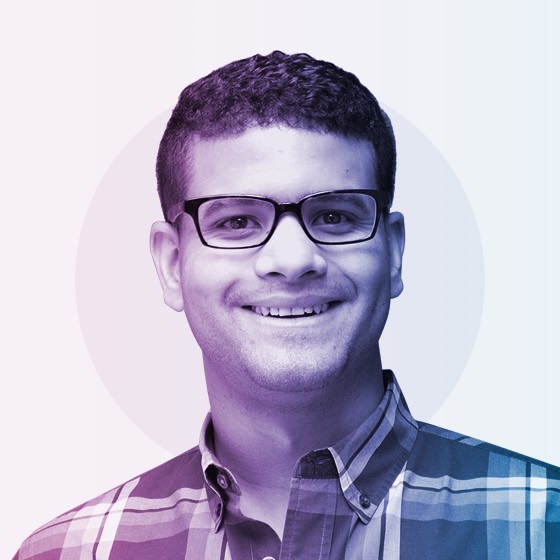
That’s the best wireframe I’ve ever heard!
Clive K. Lavery
Freelance UX Person & Full-Stack Human Being
Are you a UX/UI designer who’s wondering how to survive in a world where voice assistants like Alexa and Siri are becoming embedded in everyday human interactions? If voice really is the next big thing, what does this mean for the established methods and tools we’re using to design meaningful, screen-based experiences? And can we apply what we know about graphical user interfaces (GUIs) to the restricted world of voice user interfaces (VUIs)?

Everything but the execution
Paul Andre
Research Lead, Facebook
The difference between good or great research (or mid- to senior-level) often isn’t the execution of the work itself, but what you do before and after it. We’ll focus on a few strategies to elevate research and the product, from opinionated product thinking, broadening your scope, thinking long-term, and frameworks for creating, executing, and landing projects. Learning from past mistakes we’ll explore how to deliver insights that drive product and strategy.

Designing the future now
Leyla Acaroglu
TED speaker, award winning designer, United Nations Champion of the Earth
We know design has a powerful influence on the world but how is it shaping the future and what kind of actions should take today to ensure that our actions have positive reactions? From dark design to the ethics of interaction, Leyla Acaroglu will explore the possibilities of designing for a positive impact on the the future today.

Where did all the feelings go?
Tobias Ahlin
Lead Experience Designer, Minecraft
When we quantify the success of design we obsess over utility and task completion; retention, monthly active users, and conversion. But what about having fun? Delightfulness? Being inspired? When the current dogma is to describe good design as “clean”, “minimalistic”, and “effective“, how much room is there left to express emotion in design?
In this talk we’ll dive into the details of how UI design is approached fundamentally differently in games and apps, and what the two camps can learn from each other.

UX writing: Designing better product experiences
Yvonne Gando
Senior UX Writer, Google
Storytelling, content strategy, writing-focused design. These labels have been used to help define UX writing. But what, exactly, is it? And why should you care?
Find out how words can make or break your product experience. Through case studies on Google products, learn about the UX writing principles that guide effective design decisions across a wide range of product areas, including artificial intelligence & conversation design, social media, messaging, e-commerce, virtual/augmented reality, and education.

Good to great UI animation
Pablo Stanley
Design Lead, InVision
Let's talk about UI animation! In this talk, Pablo covers animation principles and practical tips to make your UI micro-interactions more meaningful. We'll go over the properties you can animate using time. We'll cover the anatomy of an animation that makes it go from good to great. And we'll have an overview of the different tools to get you started.

Data vs Insights
Jon Crowley
Strategy Director, Sid Lee Toronto
When it comes to content, ”data-driven“ has been the watchword for a while now. Site analytics, media metrics, surveys, device behaviours, video views, social sharing, clicks—every one of these metrics is used as proof in our industry. Someone started, not that long ago, calling these data points insights.
XX% increase in visitors who buy, if they saw X piece of content.
People in X age group are more likely to read reviews before deciding to purchase.
The chances of subscription skyrocket after reading X articles.
These aren't insights. They're data points. And content created against data points is missing an essential piece of the puzzle: the understanding of why people do what they do. Letting data overtake insights has led many of us to confuse the journey we want to take people on (the sales funnel), for the journey that people actually take (the customer journey). It's time to rethink the way we understand and interpret data.

Zooming in and out through research: Building the future of travel planning on Airbnb
Rebecca Gray, Phd
Lead Experience Researcher, Airbnb
Planning end-to-end trips can be cumbersome - from deciding when and where to go to knowing how to get around in a new city once you hit the ground. Airbnb researcher Rebecca Gray and her design partners were asked to figure out how to build a travel planning product in a way that meets travelers’ diverse needs but also continues to embody the special community-oriented quality of Airbnb.
Developing this new product has required research to cast wide nets and to ask questions in a large variety of ways -- and some questions, they simply could not have seen coming from the beginning. In this talk, she’ll share the exciting research journey to assess needs for trip planning support, evaluate the current methods people use (on and off of Airbnb), and construct the future of travel planning on Airbnb. It has required finding and listening to the patterns in huge data sets as well as digging in one-on-one with travelers over and over again, across different phases of the travel journey to come up with what Airbnb launched the first phase of in September 2018.

The future of voice
Cheryl Platz
Design Lead, Microsoft
Far from HAL or Her, the current generation of voice interfaces represents an incredibly important step forward - but the journey to the next generation of experiences is far from over. In this talk, Cheryl draws from her extensive NUI experience to highlight several key shortcomings of today’s voice interfaces. As we examine those shortcomings, we will discover important opportunities for today’s product teams that apply to both dedicated voice systems and multimodal interfaces. Together, we'll discover the path towards a future that includes more adaptive, inclusive, humane voice interfaces for all.

Designing for attention
Adrian Zumbrunnen
Designer, Google
Good design and ideas rarely happen in isolation. They are shaped by complex invisible forces that people from the outside can't observe. The bigger the organization and the team, the harder it is to get your ideas to happen.
In this talk, Adrian discusses the importance of designing for attention. This is not a talk about deception and luring people into using products they don't need. It's about framing ideas in a way that gets them noticed both in- and outside of the workplace.

Break your design: Strategies for improving your work by embracing chaos and mess
Amy Thibodeau
Director of UX, Shopify
In the tech industry we talk a lot about failure. Fail fast. Move fast and break things. Perfection is the enemy of the good. Yet if you look at Dribble or design portfolios, most of what you’ll see is beautiful, pixel perfect and orderly. This Instagramization of product design ignores the messy, chaotic, and often unpredictable humans and circumstances our work is meant to serve.
In this talk, we’ll explore a set of strategies and frameworks UXers can use to improve the user experience by breaking their designs.

Mechanical Clerk: The cascading consequences of dehumanizing design
Leah Reich
Senior User Researcher, Spotify
The best design is invisible, everyone tells us, and so we design products to feel easy and effortless. But what happens when we design products that require the humans who maintain them to also be invisible? Worse, what happens when we design products and don’t even consider these humans at all? This talk explores a part of the design process we don’t often think about or value: Human infrastructure, and the people who keep our systems and organisations running.

Designing a better bot
Kostya Gorskiy
Design Manager, Intercom
Artificial intelligence and machine learning capabilities have made leaps and bounds in the past few years, but the products and interfaces we’ve built with that technology haven’t caught up. Design plays a huge part in how users interact with bots, but there are very few examples of good bot interfaces out there right now. How do you build a great product that’s also smart and solve for problems that haven’t come up yet? Kostya will share the lessons learned building Intercom’s new bot interface, the principles that make a powerful bot, and real-world examples of how it’s being used. He’ll also address the future of bot conversations, what we can expect from digital assistants and how our conversations will adapt to the new technology.

UX Choreography & brand interaction
Rebecca Ussai
Principal Interaction Designer, IA Collaborative
In this talk, Rebecca will illustrate how the Principles of UX Choreography can help designers think about how and why to design with motion in order to craft experiences that are more fluid, delightful, and intuitive. We’ll then explore when designers can start thinking about motion in the creative process and how we can work with our teams to craft a point of view on branded behavior and interaction, ultimately creating an ownable, authentic digital experience.
If a brand were to speak to us, what would it say? If a brand were to move, what would it feel like?